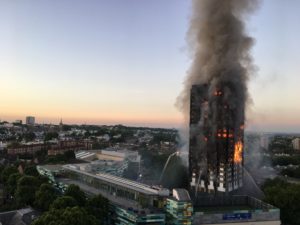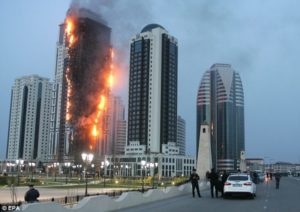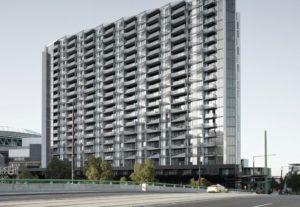
High-rise fires spur efforts to improve testing of complex systems
A pair of highly anticipated reports on fire safety engineering regulations in the United Kingdom and Australia are now in the hands of code officials, who will be using the findings to develop better ways of testing materials used in exterior cladding systems on high-rise buildings.
In June 2017, 72 people were killed when a fire broke out in a fourth-floor apartment in Grenfell Tower in West London and spread quickly to other floors when the building’s external aluminum-composite insulation caught fire and acted as a funnel, drawing flame and smoke upward. Nearly two years later, a high-rise apartment block in Melbourne, Australia, caught fire after a smoldering cigarette left on a 22nd-floor balcony ignited the building’s exterior cladding, which again allowed the fire to spread rapidly. Fortunately, no one was killed in that incident.

Independent reports on the root causes of both fires highlighted broadly similar concerns over the reliance on regulations that specify a desired result or goal, rather than on those that identify the actions or steps that must be taken to ensure compliance with safety standards. Designers often favor the former type of regulation, which is called “performance-based” or “outcome-based,” because it tends to offer greater flexibility and allows designers to be more innovative. But the performance-based approach can also backfire when regulators do not closely monitor what manufacturers, architects and builders are doing — which both reports said was a contributing factor in the London and Melbourne fires.
“Clearly problems continue to emerge in relation to design, choice of materials, façade design, poor installation, lack of proper inspections and other aspects which shake the confidence of building owners and occupants,” wrote Ashley Brinson, the executive director of the Warren Centre at the University of Sydney, in the opening of its report titled “Fire Safety Engineering Regulation, Control and Accreditation in Australia.”
In looking at the wide range of fire safety engineering practices in Australia’s states and territories, the Warren Centre report concluded that there was “clearly a need for reform and better control over the building approval and certification process,” including consistent standards for registration, licensing and accreditation of fire safety engineers as well as better ways of ensuring compliance for products and systems used in construction.
In the final report of the Independent Review of Building Regulations and Fire Safety issued last year by the U.K.’s Secretary of State for Housing, Communities and Local Government, author Dame Judith Hackitt — a keynote speaker at this year’s International Code Council Annual Conference, Code Hearings and Expo in Las Vegas — said that “the regulatory system covering high-rise and complex buildings was not fit for purpose” and in need of “a radical rethink of the whole system and how it works.”
“This is most definitely not just a question of the specification of cladding systems, but of an industry that has not reflected and learned for itself, nor looked to other sectors,” Dame Hackitt wrote, arguing that the underlying causes of the systemic failure of fire safety regulations in the U.K. were ignorance of regulations and guidance, indifference to concerns raised by residents or builders, a lack of clarity regarding stakeholders’ roles and responsibilities, and inadequate tools for ensuring oversight and enforcement.
Elected officials in Australia and the U.K. are taking to heart the findings of the Warren Centre and Hackitt reports, as well as similar arguments being made by other building experts, and have begun rolling out changes that help provide greater monitoring and accountability within their performance-based regulatory frameworks. For example, in Australia, the New South Wales government has pledged to overhaul its compliance reporting, require designers and commercial builders to be registered before they can submit plans for approval, appoint a building commissioner, and establish an industrywide “duty of care” to homeowners. In the U.K., the Parliament plans to introduce legislation that will put in place strict new safety standards for developers and landlords and establish a new nationwide building safety regulator position.
But what effect will these sweeping changes have on the code development and enforcement process, such as that employed by the International Code Council? The main concern, says Beth Tubbs, P.E., FSFPE, the Code Council’s senior staff engineer, is that these cladding systems are properly tested. The wall systems containing materials like aluminum-composite cladding, foam insulation and combustible water-resistive barriers need to be tested as complete systems, rather than as individual components.
“In countries where they haven’t fully developed their regulatory framework from the standpoint of inspection and plan review, they may not be quite at a level where they can handle these complex systems,” Tubbs said. “In other countries, deregulation seems to have removed the backstop, if you will, of an uninterested party checking everything over in the end.”
Another concern, Tubbs said, has been the lack of scrutiny when cladding systems are being installed on individual buildings. “Because these wall systems are so complicated, and because these materials often look similar even though one type of cladding material may have passed a test and the other has not, it’s very difficult if you don’t watch carefully in that regard.

Aluminum-composite materials (ACM) or metal-composite materials (MCM) are panels with metal skins bonded to both faces of a plastic core. The plastic core is typically a dense polyethelyne. MCMs are often paired with other materials such as some sort of insulation that typically consists of a low-density core material, such as polyisocyanurate foam, a combustible water-resistive barrier and an air gap. Although the individual components of a cladding system may have been tested for fire propagation, Tubbs said, the cladding system as a whole may not have been subjected to such tests. Such tests are technically required by the building code. The lack of testing may pose safety risks that builders must balance against the costs of testing.
“The foam insulation could come from one manufacturer and the cladding could come from another,” Tubbs said. “An architect might say, ‘Well, this component has passed NFPA 285 [which spells out the standard fire test methods used to evaluate the fire propagation characteristics of exterior wall systems that include combustible components], and this other component has also passed NFPA 285,’ but that doesn’t necessarily mean that they could pass NFPA 285 if they were tested together.”
“Bottom line, trying to test these systems is very, very expensive,” Tubbs said. “Technically, you’re supposed to test exactly what’s going on that building. So if you add something new or take something away or change the configuration of the system, that changes what you need to test. And these tests cost tens of thousands of dollars, if not more. And there’s a time lag to get the testing done. Due to these costs, the concept of engineering judgment is often used to assess the performance of these cladding systems without testing each time. This is considered an alternative method of compliance to the building code.”
“The big concern from an approvals standpoint is who should be allowed to make an engineering judgment on the installations themselves,” Tubbs said. “There’s a huge question about who is qualified to do that. This issue is critical and needs to be explored in detail and should be on everyone’s radar.”
In Australia, efforts to address the risks of cladding fires actually began in 2014, following a fire in the Lacrosse apartment building in Melbourne that traveled up the outside of the building but was prevented from entering due to fire-suppression sprinklers and the efforts of firefighters. Among the steps taken included a review of the National Construction Code’s (NCC) requirements related to external wall systems.
“Whilst there has been a further Melbourne cladding fire at the NEO200 apartments in 2018, which again was limited in its extent, more concerted action had already been taken following the Grenfell Tower fire in 2017 and with a clearer picture of the analysis undertaken following the Lacrosse fire,” said Neil Savery, chief executive officer of the Australian Building Codes Board. “This included the commissioning of what has come to be known as the Building Confidence Report, significant audits of buildings, banning of aluminum composite panels in specified circumstances, a new verification method and associated fire tests for external wall systems, sprinklers on balconies of new high-rise residential buildings, and the development of a labelling standard for aluminum composite panels.”
Judy Zakreski, vice president of global services for the International Code Council, says that consensus-driven model codes can serve as a way to bridge performance-based regulatory approaches like those used in the U.K. and Australia, among other places, with the traditional step-by-step prescriptive standards-driven method that can sometimes be limiting.
“The most critical piece of any code is its effective implementation and the ability of a jurisdiction to enforce and audit,” Zakreski said. “This necessitates a whole ecosystem that starts with the code and runs all the way down to enforcement. A code is only as strong as the smallest hole in the implementation process.”
While many other countries have government agencies that develop and implement building codes, the independence of the Code Council’s consensus process offers an alternative that can be more flexible and adaptive, Zakreski said, which can make it compatible with performance-based regulatory approaches.
“The more I learn about the building safety infrastructure in other countries, the more I’m convinced that we have a uniquely great system in which we’re developing model codes on a frequent basis so we can take into consideration, in close to real-time, innovations and lessons that we’re learning from experiences around the world,” Zakreski added. “The creation of a model code through an open, consensus-based process like the one that ICC facilitates allows for a full consideration of all of those issues.”

In Australia, cladding systems must meet the NCC’s performance requirements. Savery said that one way this can be done is by reference to a new Australian Standard, AS5113, for the testing of external wall systems, which itself references British and U.S. cladding fire safety standards.
Savery noted that one of the NCC’s compliance pathways permits the testing of individual components of an external wall system. “Under the ‘Deemed-to-Satisfy’ provisions, an external wall of a large building complies when each component is non-combustible, apart from some minor components as permitted by concession,” Savery explained.
While the Australian state and territorial governments have adopted private, third-party certification for many building control responsibilities, the degree to which this is done varies from jurisdiction to jurisdiction. “Generally speaking, the benefit has been speedier and less costly building approval processes as market forces have been introduced into the system,” Savery said. “I suspect some would also argue [that there has been] more consistent interpretation of the NCC.” However, the risk of potential conflicts of interest and “forum shopping” to get a more desirable decision do pose some challenges.
In her keynote address to Code Council members in Las Vegas at October’s annual meeting, Dame Hackitt emphasized that, ultimately, the purpose of a regulatory system — like model building codes — is to “drive the right behaviors.”
“The rules, the guidance, the codes will not deliver the right outcomes unless they are supported and implemented through an effective regulator,” Dame Hackitt said. “You also have to have the right incentives and sanctions in the system to drive the right behaviors. You have to be clear about who is responsible and who is accountable. There is a need for a lack of ambiguity so that people can’t interpret what they read in ways that suit them. And the guidance and the rules and the codes have to be coherent.”
“We need to shift toward a regime where those who are doing the building, those who are doing the work, are responsible for delivering the right outcomes, not simply … obeying the rules that someone else tells them to,” she said.







